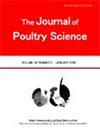Role of Corticosterone in Lipid Metabolism in Broiler Chick White Adipose Tissue
IF 1.6
4区 农林科学
Q2 AGRICULTURE, DAIRY & ANIMAL SCIENCE
引用次数: 1
Abstract
Excessive accumulation of body fat in broiler chickens has become a serious problem in the poultry industry. However, the molecular mechanism of triglyceride accumulation in chicken white adipose tissue (WAT) has not been elucidated. In the present study, we investigated the physiological importance of the catabolic hormone corticosterone, the major glucocorticoid in chickens, in the regulation of chicken WAT lipid metabolism. We first examined the effects of fasting on the mRNA levels of lipid metabolism-related genes associated with WAT, plasma corticosterone, and non-esterified fatty acid (NEFA). We then examined the effects of corticosterone on the expression of these genes in vivo and in vitro. In 10-day-old chicks, 3 h of fasting significantly decreased mRNA levels of lipoprotein lipase (LPL) in WAT and significantly elevated plasma concentrations of NEFA. Six hours of fasting significantly increased mRNA levels of adipose triglyceride lipase (ATGL) in WAT and significantly elevated plasma concentrations of corticosterone. On the other hand, fasting significantly reduced mRNA levels of LPL in WAT and elevated plasma concentrations of NEFA in 29-day-old chicks without affecting mRNA levels of ATGL in WAT or plasma corticosterone concentrations. Oral administration of corticosterone significantly reduced mRNA levels of LPL and significantly increased the mRNA levels of ATGL in WAT in 29-day-old chicks without affecting plasma NEFA concentrations. The addition of corticosterone to primary chicken adipocytes significantly increased mRNA levels of ATGL, whereas mRNA levels of LPL tended to decrease. NEFA concentrations in the culture medium were not influenced by corticosterone levels. These results suggest that plasma corticosterone partly regulates the gene expression of lipid metabolism-related genes in chicken WAT and this regulation is different from the acute elevation of plasma NEFA due to short-term fasting.皮质酮在肉仔鸡白色脂肪组织脂质代谢中的作用
肉鸡体脂肪的过度积累已成为家禽业的一个严重问题。然而,甘油三酯在鸡白色脂肪组织(WAT)中积累的分子机制尚未阐明。在本研究中,我们研究了鸡体内主要的糖皮质激素——分解代谢激素皮质酮在调节鸡WAT脂质代谢中的生理重要性。我们首先研究了禁食对与WAT、血浆皮质酮和非酯化脂肪酸(NEFA)相关的脂质代谢相关基因mRNA水平的影响。然后,我们在体内和体外检测了皮质酮对这些基因表达的影响。在10日龄雏鸡中,禁食3 h显著降低WAT中脂蛋白脂肪酶(LPL) mRNA水平,显著升高血浆NEFA浓度。禁食6小时显著增加WAT中脂肪甘油三酯脂肪酶(ATGL) mRNA水平,显著升高血浆皮质酮浓度。另一方面,禁食可显著降低29日龄雏鸡WAT中LPL mRNA水平和血浆NEFA浓度,但不影响WAT中ATGL mRNA水平和血浆皮质酮浓度。在不影响血浆NEFA浓度的情况下,口服皮质酮显著降低29日龄雏鸡WAT中LPL mRNA水平,显著提高WAT中ATGL mRNA水平。在原代鸡脂肪细胞中添加皮质酮显著提高了ATGL mRNA水平,而LPL mRNA水平有降低的趋势。培养基中的NEFA浓度不受皮质酮水平的影响。这些结果表明,血浆皮质酮在一定程度上调控了鸡WAT中脂质代谢相关基因的表达,这种调控不同于短期禁食导致血浆NEFA的急性升高。
本文章由计算机程序翻译,如有差异,请以英文原文为准。
求助全文
约1分钟内获得全文
求助全文
来源期刊

Journal of Poultry Science
AGRICULTURE, DAIRY & ANIMAL SCIENCE-
CiteScore
2.80
自引率
13.30%
发文量
26
审稿时长
12 months
期刊介绍:
The Journal of Poultry Science will publish original reports and reviews which either make an original contribution to fundamental science or are of obvious application to the industry. Subjects which are covered include: breeding and genetics, nutrition and feeds, physiology, reproduction, immunology, behavior, environmental science, management and housing welfare, processing and products, and health in poultry. Submission of original articles to the Journal is open to all poultry researchers. The review articles are invited papers written by international outstanding researchers. Articles will be published in English, American style.
 求助内容:
求助内容: 应助结果提醒方式:
应助结果提醒方式:


